Sunday 31 May 1942
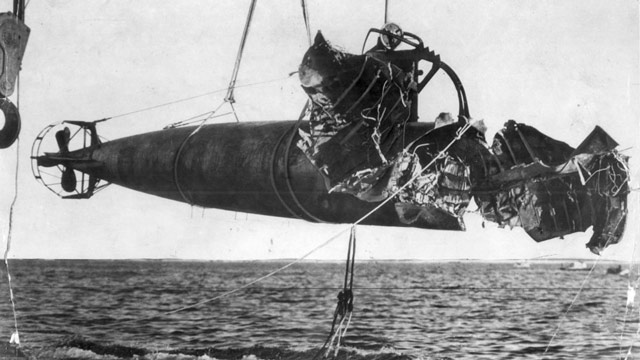 |
| A Japanese mini-sub that entered Sydney Harbour on the night of 31 May 1942 but got caught in netting. The crew, unable to escape, scuttled it with themselves inside (Gordon Short, The Sydney Morning Herald). |
Battle of the Pacific: After dark on 31 May 1942, three Japanese Kō-hyōteki-class mini-submarines, (M-14, M-21, and M-24) and their two-man crews enter Sydney Harbour, Australia. Only one of the subs, M-24, makes a successful attack, firing its two torpedoes to sink converted ferry HMAS Kuttabul (21 dead, 19 Australians and 2 British). The M-24 crew then attempts to exit the harbor only to wreck off Sydney's Northern Beaches at Bungan Head (sub discovered in 2006).
This begins a two-week-long campaign by the "mother" submarines to disrupt shipping in the area, during which they sink three ships and kill 50 sailors. The "Attack on Sydney Harbour," which includes submarines shelling Sydney and Newcastle on 8 June 1942, is the only time those cities have been attacked.
 |
| "U.S. Army Air Force Boeing B-17E Flying Fortress bombers of the 431st Bombardment Squadron take off from the airfield on Eastern Island, Midway Atoll, on the afternoon of 31 May 1942. The plane in the center is an early-model B-17E-BO (s/n 41-2397), with a Bendix remotely controlled belly turret, flown by 1st Lt. Kinney." Naval History and Heritage Command USAF-22635-AC. |
In the Central Pacific, both Japanese and US carriers are converging on Midway Island. The Japanese intend to invade, but they don't know the US Navy has discovered their plans and is lying in wait. The sides are roughly equal, with four Japanese fleet carriers opposing three US fleet carriers and land aircraft based on Midway. At Midway, B-17 bombers begin flying search operations looking for the Japanese ships. These searches, which include PBY Catalinas, focus on the seas to the north.
Admiral Nimitz is not taking any chances regarding the outcome of the upcoming confrontation at Midway. He already has ordered his only reserve aircraft carrier, USS Saratoga, to complete its repairs at San Diego and head to Pearl Harbor ASAP. Today, the navy shifts two battleships, Colorado and Maryland, to San Francisco to protect the west coast in case of a Japanese breakthrough.
US Navy submarine USS Pollack (SS-180) torpedoes and sinks Japanese auxiliary submarine chaser Shunsei Maru No. 5 off Murotosan, Japan.
B-17s of the 5th Air Force attack Lae and Salamaua, New Guinea.
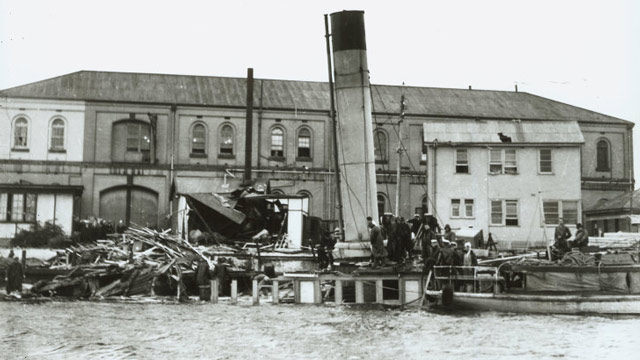 |
| Australian Navy depot ship (former ferry Kuttabul) sunk by a Japanese mini-submarine in Sydney Harbour on the night of 31 May 1942 (Gordon Short, The Sydney Morning Herald). |
Battle of the Indian Ocean: As one group of Japanese mini-subs attacks Sydney Harbour, another group has been attacking Royal Navy warships at Diego Suarez, Madagascar. Having blown a 30x30 foot hole in battleship HMS Ramillies and sunk freighter British Loyalty, the two subs exit the bay and head northwest. M-16b is lost and never found, while M-20b - the one that made the attacks - winds up beached at Nosy Antalikely (Antali Keli) islet after its battery runs out. The two crewmen receive help from friendly locals, make it to the mainland, and head for their recovery area at Cape Amber on foot.
With their cover blown, Japanese submarine I-10 launches its "Glen" seaplane for the second day in a row to fly over Diego Suarez. The British, oblivious, fail to notice.
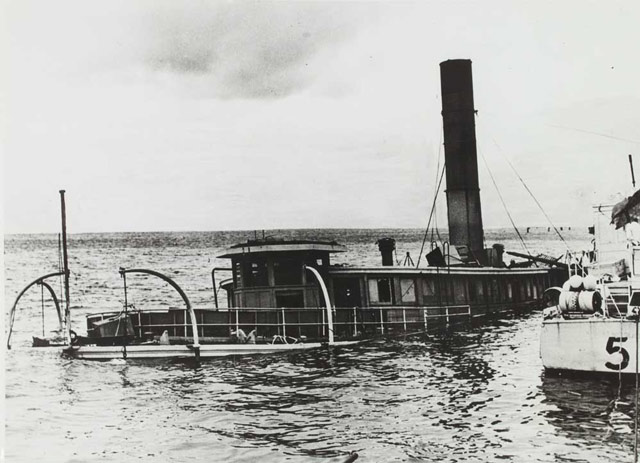 |
| Kuttabul lying on the bottom in Sydney Harbour after being torpedoed on 31 May 1942. |
Eastern Front: The front has settled down since the German victory southeast of Kharkov, where the victors are busy counting prisoners. At Fuhrer Headquarters in East Prussia, General Franz Halder comments about the upcoming Case Blue that "Build-up is proceeding according to plan."
The Germans have another big opportunity to the north, where large Soviet forces are essentially trapped on the wrong side of the Volkhov River. Halder comments, "The enemy's intention to pull out of the Volkhov bulge is now quite obvious; not clear about Pogostye bulge."
What Halder doesn't know is that General Lieutenant A. A. Vlasov, commander of the 2nd Shock Army in the bulge, has repeatedly asked for permission to retreat but has been denied. Now, Vlasov's army is so weak that it doesn't matter whether he is allowed to retreat or not. Vlasov is preparing a final, desperate breakout at Myasnoi Bor that will decide the fate of his army.
 |
| British destroyer HMS Highlander at sea, 31 May 1942 (© IWM FL 1984). |
European Air Operations: While Cologne recovers from the stunning 1000-plane RAF Bomber Command raid of 30/31 May, the British try again with a massive raid against Essen. This one, however, achieves little in comparison to the firestorm created at Cologne.
The de Haviland Mosquito bomber makes its operational debut today. Four of the bombers of RAF No. 105 Squadron visit Cologne to drop a few more bombs and take some reconnaissance photos.
The Luftwaffe retaliates for the Cologne raid with a "Baedecker Raid" against Canterbury. It causes large fires that lead to heavy damage.
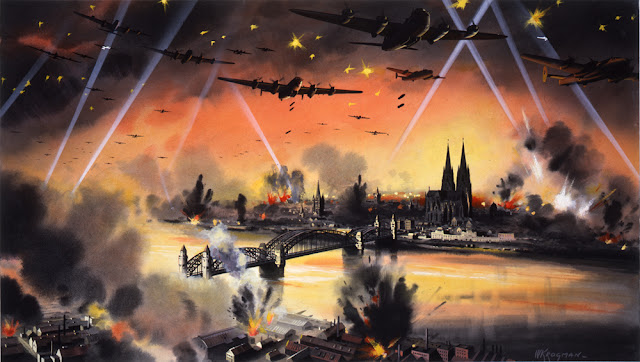 |
| Mass bomber raid on Cologne (The National Archives UK, artist unknown). |
Battle of the Atlantic: The final six ships of Convoy PQ-16 make port in Archangel, ending the convoy. PQ-16 lost eight ships, six to air attack, one to a mine, and one to U-703. Despite the losses, the Allies consider the convoy a success because of the badly needed war supplies brought to the Soviet Union. It also includes Heavy Lift Ships including SS Empire Elgar that remain in the USSR to facilitate convoy unloading for 14 months.
U-107 (Kptlt. Harald Gelhaus), on its sixth patrol out of Lorient, torpedoes and sinks 4536-ton Panamanian freighter Bushranger west of Jamaica. This sinking is sometimes said to have occurred on 1 June, as different accounts have the torpedo hitting before or after midnight on the 31st. There are 17 dead and 26 survivors, who are picked up on 12 June by UCGS USS Nike.
U-506 (Kptlt. Erich Würdemann)g, on its second patrol out of Lorient, gets its final victory of a patrol during which it has sunk eight ships of 39,906 tons and damaged three more of 23,358 tons. This victim is 2292-ton British freighter Fred W. Greene, which sinks 200 miles southeast of Bermuda. The ship is carrying 725 tons of military stores and general cargo, including 48 motor trucks, construction equipment, beer, cigarettes, and 48 bags of mail. Würdemann has to use his deck gun because he is out of torpedoes. There are five dead and 36 survivors, who are picked up on the 1st by two different US destroyers, Bernadou (DD 153) and Ludlow (DD 438).
U-432 (Kptlt. Heinz-Otto Schultze), on its fifth patrol out of La Pallice, torpedoes and sinks 1188-ton Canadian freighter Liverpool Packet 15 miles west of Seal Island (near Cape Sable), Nova Scotia. There are two deaths and 19 survivors, who make it to shore in their lifeboat at Seal Island.
Italian submarine Comandante Cappellini torpedoes and sinks 8214-ton British tanker Dinsdale southwest of St. Paul Rocks off Brazil. There are thirteen deaths.
Comandante Cappellini also torpedoes and sinks 8214-ton British Royal Fleet Auxiliary RFA Dinsdale northeast of Pernambuco. There are five dead and 52 survivors.
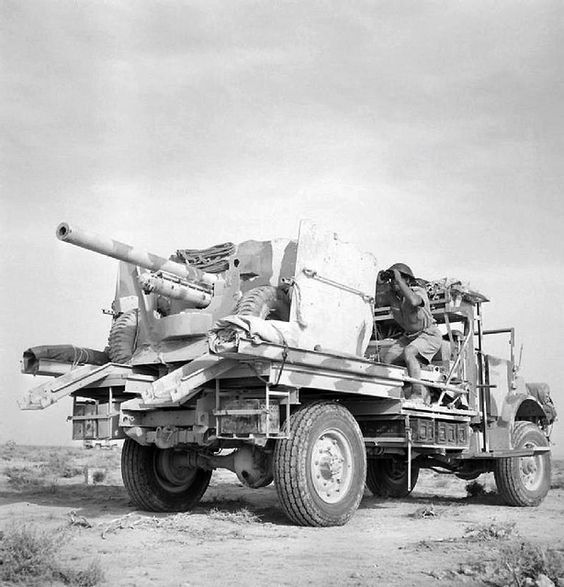 |
| Truck-mounted 6-pdr anti-tank gun in the Western Desert, 31 May 1942. |
Battle of the Mediterranean: With German General Erwin Rommel's Afrika Korps having pulled back into a defensive position called "The Cauldron," the battle along the Gazala Line has entered a new phase. The key factor for both sides is supplies for thirsty men and tanks. To solve this problem, Rommel sends the 90th Light Division and the Italian Trieste Division to assault the British 150th Infantry Brigade blocking the supplies in the 'Sidi Muftah box." The attack, launched in the morning, continues throughout the day, making good progress but not breaking through the British defenders.
In Rome, General Albert Kesselring is tired of having the British sink his supply ships to Rommel. Today, he submits a plan to invade Malta to the Italian Commando Supremo. However, the ultimate decision rests with Hitler, and he isn't ready to repeat a Crete-style invasion.
 |
| The Arizona Daily Star for 31 May 1942 headlines the previous day's Memorial Day celebrations. Off to the side is a column about the British counterattack against Rommel in Libya. |
On the Allied side, the supply situation of the Free French holding out at the fortress of Bir Hakeim is alleviated when fifty supply trucks of the 101st Transport Company break through the German encirclement. A French raid from the fort destroys five tanks and a German armored vehicle repair shop. In the air overhead, things do not go as well for the Allies. They lose fifteen fighters and a bomber, their worst losses of the battle, to nine Luftwaffe losses.
British submarine HMS Proteus and Taku torpedo and badly damage 6836-ton Italian freighter Gino Allegri about 80 miles west of Benghazi. The ship remains afloat until finished off by RAF aircraft.
HMS Proteus also torpedoes and sinks 1571-ton Italian freighter Bravo northwest of Benghazi.
Obfw. Erich Krenzke of 6./JG 27 is captured after he is forced to crash-land his Bf 109F-4 behind British lines near Acroma and El Adem. He finishes his career with eight victories.
 |
| An Italian hiking group organized by the Fascists in Mulhouse, France, hike through Upper Alsace, 31 May 1942 (Proietti, Ugo, Federal Archive Image 212-357) |
Battle of the Black Sea: Soviet submarine SHCH-214 shells and sinks 85-ton Turkish sailing ship Mahbubdihan northeast of Cape Igneada, Turkey.
US Military: US ration strength in Northern Ireland as of this date is 32,202, including 1626 officers, 102 nurses, 16 warrant officers, and 30,458 enlisted men.
American Homefront: Golfer Sam Snead, known as "Slammin' Sammy Snead," wins the PGA Championship at Seaview Country Club in Galloway Township, New Jersey. It is the first of what become seven major titles. Immediately after this event, which is the last major championships held until 1944, Snead joins the US Navy and serves in it for the remainder of World War II. Following his honorable discharge, Snead resumes winning tournaments (a record 82 PGA Tour events) until he retires in 1987. As of this writing, Snead remains tied for the most lifetime PGA Tour events won.
 |
| Bomb damage in Cologne city center from the May 30/31 RAF 1000-plane raid. This is Unter Goldschmied (Federal Archive Picture 121-1334). |
May 1942
2021
No comments:
Post a Comment